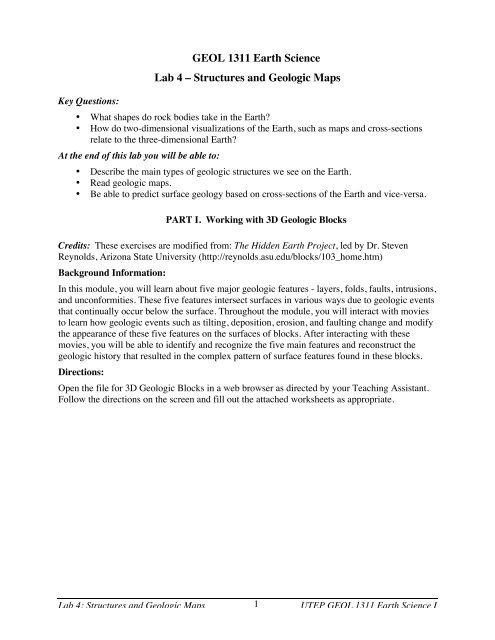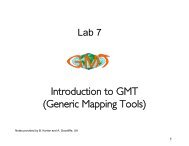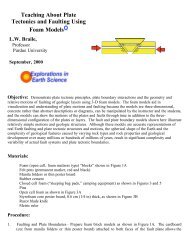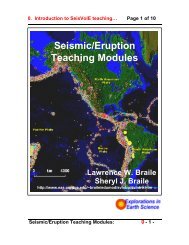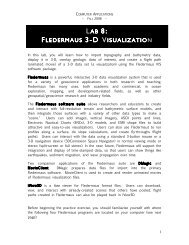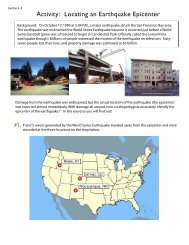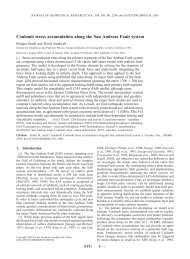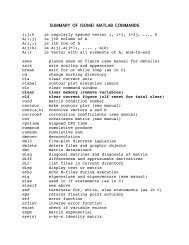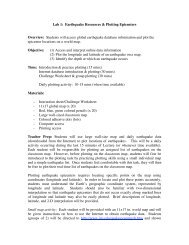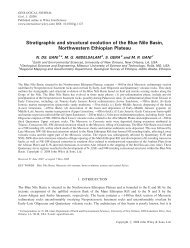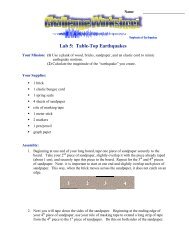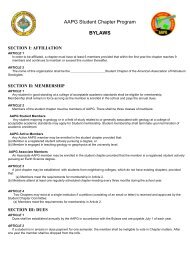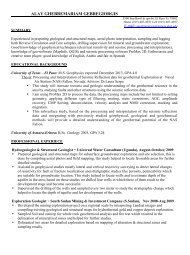GEOL 1311 Earth Science Lab 4 â Structures and Geologic Maps
GEOL 1311 Earth Science Lab 4 â Structures and Geologic Maps
GEOL 1311 Earth Science Lab 4 â Structures and Geologic Maps
- No tags were found...
You also want an ePaper? Increase the reach of your titles
YUMPU automatically turns print PDFs into web optimized ePapers that Google loves.
Key Questions:<strong>GEOL</strong> <strong>1311</strong> <strong>Earth</strong> <strong>Science</strong><strong>Lab</strong> 4 – <strong>Structures</strong> <strong>and</strong> <strong>Geologic</strong> <strong>Maps</strong>• What shapes do rock bodies take in the <strong>Earth</strong>?• How do two-dimensional visualizations of the <strong>Earth</strong>, such as maps <strong>and</strong> cross-sectionsrelate to the three-dimensional <strong>Earth</strong>?At the end of this lab you will be able to:• Describe the main types of geologic structures we see on the <strong>Earth</strong>.• Read geologic maps.• Be able to predict surface geology based on cross-sections of the <strong>Earth</strong> <strong>and</strong> vice-versa.PART I. Working with 3D <strong>Geologic</strong> BlocksCredits: These exercises are modified from: The Hidden <strong>Earth</strong> Project, led by Dr. StevenReynolds, Arizona State University (http://reynolds.asu.edu/blocks/103_home.htm)Background Information:In this module, you will learn about five major geologic features - layers, folds, faults, intrusions,<strong>and</strong> unconformities. These five features intersect surfaces in various ways due to geologic eventsthat continually occur below the surface. Throughout the module, you will interact with moviesto learn how geologic events such as tilting, deposition, erosion, <strong>and</strong> faulting change <strong>and</strong> modifythe appearance of these five features on the surfaces of blocks. After interacting with thesemovies, you will be able to identify <strong>and</strong> recognize the five main features <strong>and</strong> reconstruct thegeologic history that resulted in the complex pattern of surface features found in these blocks.Directions:Open the file for 3D <strong>Geologic</strong> Blocks in a web browser as directed by your Teaching Assistant.Follow the directions on the screen <strong>and</strong> fill out the attached worksheets as appropriate.<strong>Lab</strong> 4: <strong>Structures</strong> <strong>and</strong> <strong>Geologic</strong> <strong>Maps</strong>1UTEP <strong>GEOL</strong> <strong>1311</strong> <strong>Earth</strong> <strong>Science</strong> I
Name ________________________________ <strong>Geologic</strong> Blocks: 103 WorksheetL-1 Sketch L-2 Sketch L-3 SketchF-1 Sketch F-2 Sketch F-3 Sketch
Name ________________________________ <strong>Geologic</strong> Blocks: 103 WorksheetDirection of faulting:Visual clues used:Ft-1 Describe Ft-2 Sketch I-1 Describe1.2.3.4.I-2 List Order of Events (old to young)s (old U-1 Sketch
Blocks Module Student GuideIn this module, you will learn about five major geologic features - layers, folds, faults,intrusions, <strong>and</strong> unconformities. These five features intersect surfaces in various ways due togeologic events that continually occur below the surface. Throughout the module, you willinteract with movies to learn how geologic events such as tilting, deposition, erosion, <strong>and</strong>faulting change <strong>and</strong> modify the appearance of these five features on the surfaces of blocks. Afterinteracting with these movies, you will be able to identify <strong>and</strong> recognize the five main features<strong>and</strong> reconstruct the geologic history that resulted in the complex pattern of surface features foundin these blocks.The movies included in this module are QuickTime Virtual Reality (QTVR) movies <strong>and</strong>allow you to click-<strong>and</strong>-drag the mouse to change features in them. Above each movie, arrowswill indicate the direction(s) you can move the mouse <strong>and</strong> text will indicate what changes willoccur as you click <strong>and</strong> drag the mouse. Most sections begin with rotating movies so you cansee the four sides <strong>and</strong> top of a block. These movies can be rotated by clicking <strong>and</strong> dragging themouse from left to right (or right to left). The slower you drag the mouse, the smoother thechanges will be. Other movies allow you to change two features at a time. For example, somemovies let you rotate a block (clicking <strong>and</strong> dragging side-to-side) as well as making the blockpartially transparent so you can see features beneath the surface (by clicking <strong>and</strong> dragging up<strong>and</strong>-down).For movies with two changes in them, dragging the mouse diagonally will causeboth changes to occur simultaneously. To prevent this, try to drag the mouse horizontally <strong>and</strong>then vertically (or vertically <strong>and</strong> then horizontally). Note: You can also use the arrow keys onthe keyboard to make these changes occur <strong>and</strong> have more careful control over the changes.Other movie types in this module allow you to:cut into a block (from the left, from the right, <strong>and</strong> from the top) so you can see how aprocess such as erosion would change the surface of a block.offset the fault to observe how layers or folds would appear to change after faulting occurs.You can also simulate erosion by cutting into the blocks, rotate the blocks, <strong>and</strong> changethe amount of transparency.reveal the unconformity to see the boundary between old <strong>and</strong> young rocks (where there is alarge gap in time in which no distinct events occurred).While progressing through this module, you will be asked to complete various activitieson worksheets. Questions on the worksheets will ask you to: sketch a missing face of a block;sketch a block after imagining it has been cut into; sketch a face of a block after it has beenfaulted; describe the differences between types of faults, how they change features, <strong>and</strong> how theycan be recognized in the field; list geologic events in the order they occurred; describedifferences in types of intrusions; <strong>and</strong> draw unconformities. Make sure you have the worksheetfor each section before you begin.This module was designed to help you form your own definitions of terms <strong>and</strong>procedures. For this reason, answers will not always be provided for confirmation. The same istrue of the application questions at the end of each section. Try to formulate your own answerson your own or in your group before asking your teacher for help.
Use the Quicktime movie that illustrates strike <strong>and</strong> dip to help you with the following fordiagrams.1. Draw three horizontal layers. 2. Draw three vertical layers.The dip of these layers is_____ºThe dip of these layers is_____ºThe direction of dip is _______The direction of dip is _____3. Complete this block. 4. Complete this block.a b c dNN45º 450660ºThe strike of these layers is______The strike of these layers is_____The dip (direction <strong>and</strong> angle)of these layers is______The dip of these layers is_____The oldest layer is________<strong>Lab</strong> 4: <strong>Structures</strong> <strong>and</strong> <strong>Geologic</strong> <strong>Maps</strong>5UTEP <strong>GEOL</strong> <strong>1311</strong> <strong>Earth</strong> <strong>Science</strong> I
Background Information:PART II. Working with a <strong>Geologic</strong> Map<strong>Geologic</strong>al maps represent 3D geology on a 2D surface – similar to regular maps.The different colors on a geologic map show different rock formations. Formations are packagesof rocks of the same type <strong>and</strong> age that are distinct from surrounding rocks.Elements of a <strong>Geologic</strong>al Map:• Legend• Scale• Stratigraphic columnThe following symbols are used to denote geologic periods:Pc – Precambrian (4,500 to 543 mya)C -- Cambrian (543 to 490 mya)O – Ordovician (490 to 443 mya)S – Silurian (443 to 417 mya)D – Devonian (417 to 354 mya)M – Mississippian (354 to 323 mya)P – Pennsylvanian (323 to 290 mya)P – Permian (290 to 248 mya)T -- Triassic (248 to 206 mya)J -- Jurassic (206 to 144 mya)K – Cretaceous (144 to 65 mya)T – Tertiary (65 to 1.8 mya)Q – Quaternary (1.8 mya to today)• Contacts: Contact lines are heavier, <strong>and</strong> separate different rock units.• On a geologic map, faults are shown as solid lines, <strong>and</strong> the dip is usually given.• Rock units on a map will have one of the preceding letters as the first part of the symbolfor the rock unit; the second part will be part of the formation name. For example, Kfmeans “Cretaceous Finlay (limestone),” while Qal means “Quaternary alluvium.”<strong>Lab</strong> 4: <strong>Structures</strong> <strong>and</strong> <strong>Geologic</strong> <strong>Maps</strong>6UTEP <strong>GEOL</strong> <strong>1311</strong> <strong>Earth</strong> <strong>Science</strong> I
Directions: Answer the following questions using the geologic map of Texas.1. Describe, in words, the color pattern on this map. What do you see?2. What is the oldest rock unit on the map? Write out its name AND its symbol.3. What is the youngest rock unit? Write out its name AND its symbol.4. How are faults shown on this map? Draw some of the symbols.5. If you follow I-35 from Dallas to San Antonio, you are following the Balcones Escarpment.What is the Balcones Escarpment? HINT: use the cross section on the back labeled U2-U3.6. What kind of rocks are the TV formations between El Paso <strong>and</strong> Alpine?7. As you drive from Fort Worth to Big Spring, do the rocks get older or younger?<strong>Lab</strong> 4: <strong>Structures</strong> <strong>and</strong> <strong>Geologic</strong> <strong>Maps</strong>7UTEP <strong>GEOL</strong> <strong>1311</strong> <strong>Earth</strong> <strong>Science</strong> I
8. As you drive from San Antonio to Corpus Christi do the sediments get older or younger?9. Look at cross section F-F1. Locate the Live Oak Creek area <strong>and</strong> look in the pC formation tolocate the vertical fault. Estimate the amount of displacement on the fault in the pC.10. Look at cross sections E-E1. Locate the (green) Cretaceous rocks <strong>and</strong> follow them with yourfinger from the Fort Worth Basin to the Louisiana border. How many <strong>and</strong> what type of geologicstructures do you see?11. Look in the explanations to find the Precambrian rocks; find the pink granites <strong>and</strong> the brownmetamorphic rocks. How many places in Texas are they exposed at the surface? What kinds ofrock (igneous, metamorphic, sedimentary) are most exposed in Texas?Preparing for the <strong>Lab</strong> Quiz• Practice with 3D blocks at http://reynolds.asu.edu/blocks/103_home.htm.• Given a diagram of any geologic structure, are you able to identify the structure (e. g.anticline, syncline, normal fault, reverse fault, strike-slip fault?• For diagrams of faults, can you identify direction of motion with arrows?<strong>Lab</strong> 4: <strong>Structures</strong> <strong>and</strong> <strong>Geologic</strong> <strong>Maps</strong>8UTEP <strong>GEOL</strong> <strong>1311</strong> <strong>Earth</strong> <strong>Science</strong> I


